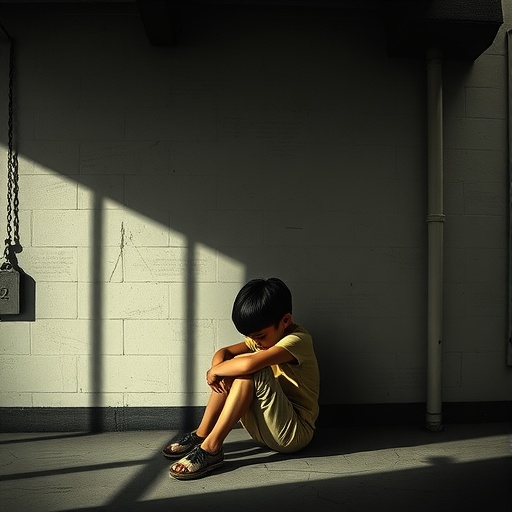In a groundbreaking investigation into the psychological complexities underlying suicidal ideation among vulnerable youth, a new study has shed light on the intricate mental landscapes of left-behind children (LBC) facing depression risks in China. Published in the 2025 volume of BMC Psychiatry, this research employs advanced computational modeling to unravel the nuanced patterns of suicidal thoughts, revealing the critical role of positive and negative ideations in modulating suicide risk. By leveraging an Ising network model—a sophisticated approach borrowed from statistical physics—researchers have provided a novel lens to interpret the dynamic interplay of emotional factors in a population often overlooked by traditional mental health frameworks.
The focus on left-behind children—a demographic referring to children remaining in rural areas while one or both parents migrate for work—highlights an urgent social and mental health concern. These children frequently experience isolation, disrupted care, and heightened psychological distress, culminating in increased vulnerability to depression and suicidal ideation. The study draws on a substantial cohort of over 10,000 left-behind children identified as having depression risk within China’s extensive Psychological Healthcare Guard Children and Adolescents Project, aiming to map out hidden subgroups within this population based on their suicidal ideation characteristics.
Employing latent profile analysis as a starting point, the research delineated three distinct suicidal ideation subgroups among these children: low, moderate, and high risk. These categories not only correlated strongly with differing levels of depressive symptomatology but also revealed variable patterns in how positive and negative suicidal thoughts manifested. This stratification enabled a person-centered understanding rather than treating suicidal ideation as a homogenous phenomenon, thus opening avenues for more tailored intervention strategies.
Central to this study is its innovative use of the Ising computational network model, which treats each suicidal ideation symptom as a node linked by probabilistic interactions. This model captures the complexity of mental states as a network of interconnected influences rather than isolated variables. Remarkably, the findings underscore the dominance of positive suicidal ideation nodes—such as feelings of life satisfaction and future confidence—across all subgroups, eclipsing the presumed influence of negative suicidal ideation like life frustration, which was nevertheless a significant factor at the aggregate level.
The implications of these results are profound when considering intervention design. Simulated interventions modeled in the study revealed that targeting positive emotional states yielded the most substantial effects in reducing overall suicidal ideation risk. Particularly for the high-risk subgroup, enhancing positive ideation nodes could reverse escalating suicidal tendencies more effectively than focusing solely on negative symptoms. This finding challenges the traditional therapeutic emphasis on alleviating negative cognition by highlighting the potent protective effects of fostering positive psychological resources.
One of the most striking revelations of the study was the responsiveness of the high-risk group to simulated aggravation interventions, showing an increase of nearly two points in risk scores when positive ideation was undermined. This sensitivity accentuates the critical importance of positive emotions as a buffer against suicidal impulses and calls for mental health policies that prioritize strengthening hope and life satisfaction among vulnerable children.
The study also provides a blueprint for the future development of personalized psychotherapeutic strategies. By identifying subgroup-specific key nodes within the suicidal ideation network, mental health practitioners can devise more precise, individualized treatment plans that go beyond one-size-fits-all methods. These plans would strategically bolster positive thoughts and attitudes, making interventions not only more effective but also potentially more engaging for young patients.
This research’s fusion of network science with clinical psychology represents a methodological leap forward. The Ising model, often used in physical systems to model interactions at a micro-level, is here adeptly applied to capture the fluid, nonlinear dynamics of mental health symptoms. This approach helps to dismantle the reductionist views of suicide risk factors, instead portraying a complex adaptive system where psychological states influence one another in cascading ways.
Moreover, the study’s extensive sample size enhances the generalizability of its findings, offering policymakers and mental health professionals robust data on an often underrepresented yet critically vulnerable group. Understanding these latent subgroups will be crucial in crafting community-level interventions and resource allocation that can mitigate the rising suicide rates among left-behind children in China and potentially other global contexts facing similar demographic challenges.
Beyond its immediate clinical implications, this research also prompts broader reflections on the psychosocial environments influencing left-behind children. It underscores the necessity of supportive frameworks that not only address mental health symptoms directly but also foster positive life experiences and perceptions, which can serve as pivotal protective factors against despair and suicidal tendencies.
The insight that positive ideation nodes wield greater influence in both aggravating and alleviating suicidal risk positions positive psychology at the forefront of suicide prevention research. It challenges prevailing mental health narratives, urging a shift toward holistic care models that integrate emotional enrichment and resilience-building with traditional symptom management.
Ultimately, this study illuminates a pathway toward more compassionate and scientifically informed approaches to youth mental health. By embracing computational models and nuanced symptom profiling, researchers and clinicians can better navigate the complexities of depression and suicidal ideation, offering hope to many children caught in the silent crises of their minds.
As mental health challenges escalate globally, particularly among marginalized populations such as left-behind children, innovative research such as this is vital. It not only deepens our understanding but also energizes the pursuit of interventions that are as dynamic and multifaceted as the human psyche itself. Through embracing complexity and focusing on positive transformation, the mental health field moves closer to halting the tragic trajectory of youth suicide.
Subject of Research: Subgroups of suicidal ideation and intervention responses among left-behind children with depression risk.
Article Title: Subgroups of suicidal ideation and simulated intervention responses among left-behind children with depression risk: an Ising computational network model.
Article References:
Yu, X., Li, L., Liu, C. et al. Subgroups of suicidal ideation and simulated intervention responses among left-behind children with depression risk: an Ising computational network model.
BMC Psychiatry 25, 774 (2025). https://doi.org/10.1186/s12888-025-07207-2
Image Credits: AI Generated




